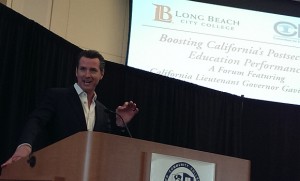College report and Toyota news place California economy at crossroads

Lt. Gov. Gavin Newsom speaking at Long Beach City College. (Photo Credit: John Guenther)
In the week following the Toyota relocation news, California saw a good amount of hand-wringing, followed by finger-pointing at reasons for the move. Whichever reason is given, it still should add fuel to the resistance to do things in the same way, including how the state educates its workforce, and be surprised when another company leaves California.
“Substantively for the 3,000-plus people, that may be displaced, that won’t make their way to Texas, and for Torrance…it’s incredibly impactful and damaging,” said Lt. Gov. Gavin Newsom. “But it’s just another blow to our reputation. The reputational impact is even more profound than the aggregate amount.”
The Toyota story was not the main topic of the day when Newsom and education leaders spoke at a higher education event at Long Beach City College on Wednesday. But it did add some urgency to what is already a pressing issue for the California economy. The panel came together to comment on a report created by the Committee on Economic Development that says the state will own a workforce gap of 1 million college-educated workers in a decade.
Newsom and others made the point that, if California wants to make it worthwhile for companies to operate here, it will require changing the higher education model so that it can retain the best workforce in the nation.
Yet, the consensus of panelists was the state’s education system, while extensive and poised to make a difference, is still designed for a business world that doesn’t exist anymore and isn’t nimble enough to respond to the demand for employees with the right skills out in the real world.
“You can’t have an economic development strategy without a workforce development strategy,” said Newsom. “In the past we could afford to be more expensive because we substantively had a better workforce than almost anyone else. We’re now seeing that erode.”
The report makes the case that the new economy has left the state’s education system behind in terms of matching workers’ skills with the needs of companies and helping people move into the middle class.
Patrick Callan, president of the Higher Education Policy Institute and who used to work at a Ford plant in Milpitas as a young man, said the world where that type of job bought you a house in California is gone and that education here hasn’t caught up with the new reality yet.
“We didn’t design in California, or anywhere else in the country, a higher education system that would have to serve so many people that would be basically the route to the middle class,” said Callan.
Ideas talked about included placing more weight on setting goals and metrics on colleges and tying funding into that equation.
Alma Salazar of the Los Angeles Area Chamber of Commerce added, with an estimated 5,000 jobs lacking qualified applicants in the L.A. area, the education system should be moving at a quicker pace and also trying to focus more on funding success while maintaining access to the college system.
“When funding is based on inputs, there really isn’t sufficient policy incentive to focus on outputs,” said Salazar.
The CED report recommends building more partnerships between the big industries in each of California’s regions and the college system. The California Economic Summit and others have made those partnerships top priorities in order to close skills gaps in in-demand job fields. That push to partner up includes building more certifications that show employers that graduates have the right skills to thrive, said LBCC Superintendent-President Eloy Oakley.
“I think what we know now, based on all these reports that have come out, is that we’re not producing enough of our adult population and enough students with some sort of credential that they can use to survive in the economy,” said Oakley.
And with the country’s largest higher education system located in California, the important job of producing an effective workforce here will have effects nationally, especially with a push by the White House to boost technical education and other aspects of post-secondary systems.
“I would just point out that the U.S can’t do that without California,” said David Dowell, CalState Long Beach’s interim provost and senior vice president for academic affairs. “It has one in six people in higher education. California can’t do that without the CSU’s. And in addition, the large CSU’s are located in Southern California. So, we’re literally sitting at ground zero of the national strategy for future economic competitiveness.”
That leaves California with plenty of incentive to help students not only build up that “best workforce” that companies can’t live without, but also start up the next companies that can create those 3,000-plus jobs.
“So for me, in one way, it’s not a surprise if Toyota is leaving,” said Oakley. “But on the other hand, I think we can use it as an opportunity to really bring people to the table and focus on what kind of climate are we going to create so that businesses can thrive in this community, so that jobs can be created and that we can create the next large employers here at home.”
Originally published on CAeconomy.org.

Dr. Ansari on health care’s future amid demographic shifts
Original story on permanente.org During a recent CEO workgroup panel, “Advancing Your Culture…
December 23, 2024
Drs. Hoberman and Nguyen on preparing for health care AI
Original story on permanente.org Many questions surround the advancements of artificial intelligence in…
October 30, 2024